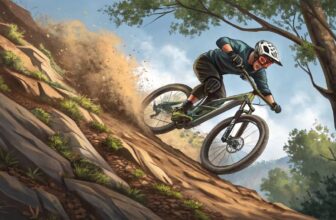Understanding MTB Drivetrains
Getting a grip on the ins and outs of mountain bike drivetrains can be a game-changer, whether you’re just stepping into the mountain biking scene, thinking about pimping out your current ride, or you’re a hard-core biking pro. Here, we break down the nitty-gritty between two big players: 1X and 2X drivetrains, and what makes each tick.
1X vs. 2X Drivetrains
Knowing the ropes about how MTB drivetrains work helps when you’re knee-deep in bike mods or repairs, especially when it comes to the 1X and 2X setups.
1X Drivetrains
The 1X drivetrain ditches the front derailleur, boasting a single chainring while keeping things sleek and sweet. Here’s why it rocks:
- Featherweight Champion: Shedding extra parts means less heft to haul.
- Maintenance Made Easy: Fewer bits mean less fixing and fiddling around.
- Simple Sailing: One less shifter lets you focus on crushing the trail, not wrestling gears.
1X sets come with chainrings that use a ‘narrow-wide’ tooth pattern, gripping the chain like a champ—tackling those bumpy trails without breaking a sweat.
| Drivetrain Type | Components | Maintenance | Weight |
|---|---|---|---|
| 1X | Single chainring, No front derailleur | Low | Light |
| 2X | Double chainring, Front derailleur | High | Heavier |
2X Drivetrains
The 2X system brings two chainrings and a front derailleur to the party. What’s it got up its sleeve?
- Gear Galore: Offers a buffet of gears when the trail tosses random challenges your way.
- Adaptability is Key: Perfect for jumping between gnarly climbs and speedy descents.
Sure, the 2X setup means lugging around some extra weight and tinkering more, but it makes up for it with its versatility.
Efficiency Factors in Drivetrains
Drivetrain performance boils down to things like how heavy they are, how much love they need, and how the gear ratios play into the ride.
Weight
- 1X Drivetrains: They’re the lightweight champs—no front derailleur, no fuss.
- 2X Drivetrains: Come with the territory—you’ve got extra parts, you get extra weight.
Maintenance
- 1X Drivetrains: Low fuss with fewer parts to worry about.
- 2X Drivetrains: Needs regular TLC to stay top-notch.
Gear Ratios
Which way you lean—1X12 or 2X11—mostly depends on your biking groove. 2X11 is great for those wanting every gear under the sun. Meanwhile, 1X12 keeps things light and easy-breezy.
By wrapping your head around these factors, you’re geared up to choose the setup that syncs with your riding style. Check out our stash on MTB gear ratios for more tips on juicing up your bike game.
Compatibility Considerations
Picking out or upgrading the inner workings of your mountain bike isn’t just a fun shopping spree—it’s about making sure everything plays nice together for that buttery smooth ride. Focus on these two biggies: making sure the stuff upfront (like the front derailleur) is compatible and checking if all the parts hail from the same bike family.
Front Derailleur Compatibility
That front derailleur is pretty much the diplomat of your bike’s shifting world. Keeping it all in the family (same brand and series) is typically the best move to keep all those gear transitions smoother than buttered corn (source: BikeRadar). Mix and match can sometimes lead to a clunky orchestra of gears.
But sometimes, you can play the role of a mad scientist and mix it up a bit. Like using a 10-speed shifter with a 9-speed derailleur. It’s like wearing two different socks—it can work if sorted correctly, just watch those limit screws so the chain behaves (source: Bicycles Stack Exchange).
| Front Derailleur | Compatible Shifters |
|---|---|
| Shimano 9-Speed | Shimano 9-Speed |
| Shimano 10-Speed | Shimano 10-Speed |
| SRAM 11-Speed | SRAM 11-Speed |
Series and Manufacturer Match
Sticking to parts from the same brand family is usually the magic ticket for the best bike harmony. Shimano’s indexed gear shifting, which turned heads back in the ’80s, screams for harmony between shifters, derailleurs, and drivetrains. Even slight differences can make your bike sing off-key.
Take the 7900 STI levers—they were meant to be similar to the 7800 front derailleur. But, surprise! They don’t always get along as you’d think, even according to Shimano. So, for peace and quiet on the trail, make sure your speed settings match up nicely.
| Series | Recommendation |
|---|---|
| Shimano Dura-Ace | Stick with other Dura-Ace pals |
| SRAM XX1 | Get cozy with other XX1 pieces |
| Campagnolo Super Record | Chill with other Super Record bits |
If you’re itching to pump up your bike’s drivetrain, following what the brand suggests keeps you on the exciting side of biking without risking a breakdown. Dive deeper into how mtb gear ratios and mountain bike maintenance keep rides optimized and worry-free.
Wrapping your head around these tech tracks will make sure you’re in for an epic and bump-free spin, whatever rocky roads call your name. Whether you’re just getting into the mountain bike groove or have tales to tell, tuning into these tips can make your adventures that much more thrilling. Keep learning with our in-depth guides on mountain bike sizing and bleed mtb brakes.
Drivetrain Components
Getting the lowdown on what makes a mountain bike (MTB) drivetrain tick is key for riders aiming to nail MTB drivetrain compatibility. This section dives into how these pieces work together and the adventures you might have mixing parts from different brands.
Functionality of Complete Drivetrains
Mountain bike drivetrains are a fascinating bunch, typically featuring a lineup of cassettes, chains, chainrings, derailleurs, and shifters. These bits and bobs make it possible for your ride to change gears with the grace of a prima ballerina.
Most MTBs rock either a 1X or 2X system: the 1X sticks with a single chainring without a front derailleur, teaming up with a hefty cassette in the back. It’s all about less fuss and more fun, offering simplicity and lightness—hence it’s been crushing it on the popularity charts for modern bikes.
On the flip side, a 2X drivetrain—more of a road bike champ—comes with two chainrings and a front derailleur for a big galore of gear options. But juggling the extra bits makes it heavier and trickier for mountain trails.
To get maximum performance, it’s wise to stick with parts from the same crew and brand, creating a harmonious dance of components that keeps shifting spot on. Thanks to Shimano’s brilliant 1984 hit, indexed shifting, we’ve experienced a boost in accuracy, though it needs specific coordination between shifters and derailleurs.
Mix-and-Match Possibilities
Mixing it up with drivetrain parts can cut costs and boost performance, but you gotta be wise about compatibility jazz. Combining gear from different bands sometimes rocks and sometimes flops. For instance, if you want to pair a 10-speed shifter with a 9-speed derailleur, prepare for some awkward shifting moments.
Some brands play nicer together than others. SRAM chains and cassettes, for example, are chummy with Shimano gear as SRAM borrowed Shimano’s specs for these bits. But when it comes to Campagnolo, they’ve got their own gig going on, making them a true blue Campy-only compatible crew.
| Components | Compatible With |
|---|---|
| SRAM Chains & Cassettes | Shimano |
| Campagnolo Chains & Cassettes | Only Campagnolo |
| 10-Speed STI Shifter | Not with 9-Speed Derailleur |
For enthusiasts who like to tinker, understanding the nuts and bolts of each part is critical. Grasping details like mtb gear ratios can be the secret sauce in picking the perfect cassette and chainring combo.
In a nutshell, mixing parts to tweak performance or save some bucks is definitely doable, but it requires an eye for detail and a good grasp of what gets along with what. For more on beating compatibility and other bike DIY tricks, swing by our diy mountain bike repairs article.
Freehub Designs
Freehub designs are like the unsung heroes of bike compatibility, quietly making sure our mountain bike setups are as smooth as a well-oiled machine. In this piece, I’ll shed some light on Shimano’s Hyperglide and SRAM’s XD and XDR systems, handy info for anyone fiddling with their bike gears.
Shimano’s Hyperglide Freehub
Old Shimano’s been at it a while, and their Hyperglide design shows it. Compatible with a bunch of speed setups, it’s pretty much a jack-of-all-trades. Got an 11-speed Shimano or SRAM? You’re in luck. Just slap on those cassettes, and you’re good to roll. It’s even flexible enough to handle 8, 9, or 10-speeds if you don’t mind throwing in a couple of spacers (Source).
| Speed Setup | What Fits | Quick Note |
|---|---|---|
| 11-speed | Shimano/SRAM cassettes | Fits like a glove for road bikes |
| 10-speed | Shimano/SRAM cassettes | Needs a spacer |
| 9-speed | Shimano/SRAM cassettes | Spacer needed |
| 8-speed | Shimano/SRAM cassettes | It’s spacer time |
If you’re always tinkering or thinking about a future upgrade, Hyperglide’s your buddy. Want more deets on overhauling your bike bits? Peep our upgrade guide.
SRAM’s XD and XDR Systems
SRAM’s a bit of a maverick with its XD and XDR systems, each offering its quirks for mountain and road bikes.
SRAM XD System
This system’s got its eyes on the mountains, tailor-made for those tight 10-tooth sprockets. It’s got a shorter body, a bold move from the usual freehub design, giving you more gear range when you’re tackling those gnarly trails.
| Freehub | Smallest Sprocket | Best For |
|---|---|---|
| SRAM XD | 10-tooth | Tough mountain gears |
If your chain’s screaming for some TLC, swing by our handy guide on chain care.
SRAM XDR System
On the road side, the XDR system stretches its muscles a bit, with an extra 1.85mm for those fancy 12-speed road cassettes. It’s built and ready for SRAM’s wireless eTap AXS setups, too.
| Freehub | Width | Best For |
|---|---|---|
| SRAM XDR | 1.85mm extra | Slick 12-speed road gears |
Whether you’re dodging rocks or cruising pavements, there’s an SRAM for that. Curious about how gear ratios affect your ride? Dive into our gear ratios article.
When it comes down to it, picking the right free’s no small thing—it’s what keeps your bike’s heart ticking just right. Shimano or SRAM, each has its flavor and flair, so choose wisely and ride on!
Campagnolo Freehub Bodies
Campagnolo freehub bodies are special because they’re like the exclusive club of freehub bodies, mostly mingling with Campagnolo components. Let’s break down what makes them stand out.
Unique Specifications
Campagnolo freehub bodies are known for their deep splines, unlike the shallower ones you’d find in Shimano or SRAM. This makes them best buddies with Campagnolo cassettes. The design helps everything work smoothly together within their drivetrains, which is great if you’re looking to improve mountain bike drivetrain compatibility.
Interestingly, Campagnolo likes to keep it simple with a single freehub design covering different speeds from 9-speed to 12-speed. They’ve recently stepped it up with the N3W freehub body for those who fancy 13-speed cassettes.
| Campagnolo Freehub Compatibility | Number of Speeds |
|---|---|
| Standard Campagnolo | 9, 10, 11, 12 |
| N3W Freehub Body | 9, 10, 11, 12, 13 |
Figures snatched from Bike Radar
The idea behind their standardized design is to make everything fit nicely into their own setup, making it less of a headache when you want to upgrade or keep up with bike maintenance. Check out more on mountain bike maintenance.
Compatibility and Updates
Campagnolo introduced the N3W as something fresh mainly for their Ekar gravel bike groupset. It can handle 13-speed cassettes with sprockets as tiny as nine teeth, giving you more gears to play with and stepping up performance in MTB gear ratios.
What’s cool about the N3W free is it doesn’t mind going back in time. With a simple adapter, it welcomes the old-school standard road Campagnolo cassettes, making it a nifty choice for those who like to switch up their drivetrain situation.
For mountain bikers, especially those tinkering with their setup, knowing what Campagnolo freehub bodies bring to the table can really help when contemplating drivetrain improvement. Whether you’re keeping an eye on budget bicycles under 1000 bucks or into serious competitive cycling, these evolving features and adaptability of Campagnolo freehubs deliver good insights for a top-notch riding experience.
You might want to also check out these guides:
- mtb chain maintenance
- mtb suspension setup
- mountain bike brake comparison
- mountain bike gear ratios
Evolution of Drivetrains
Mountain bike drivetrains have come a long way, morphing from basic setups to high-tech, efficient configurations. Getting a handle on this progression can make life a lot easier when picking out the right gear for your mountain biking adventures.
Development from 8 to 12 Speeds
The switch from 8-speed to 12-speed drivetrains marks some serious stepping stones in MTB tech. Those old-school 8-speeds may have been the start, but they laid the groundwork for the blitz of higher-speed models that followed.
| Drivetrain Speed | What It Offers | When It Popped Up |
|---|---|---|
| 8-speed | Basic, fewer gears, simple upkeep | Varies |
| 9-speed | Threw in another sprocket, gave a better gear range | Late 1990s |
| 10-speed | Compact but offers more range | Early 2000s |
| 11-speed | More range with another sprocket tossed in | Mid 2010s |
| 12-speed | The latest and greatest, 12 gears at the rear make for a versatile ride | Late 2010s |
A big game-changer was Shimano rolling out their 12-speed systems back in 2018. Adding in a single chainring with a 510% gear range really shook things up. This kicked off improvements like narrower chains and precision derailleurs.
Personalized Gear Ratios
Riders today are in luck—they can pick gear ratios that fit their riding style like a glove. Knowing about mtb gear ratios can kick your performance up a notch. These days, you’ve mostly got two setups to choose from: 1x and 2x drivetrains.
| Drivetrain Type | What’s Good | What’s Not |
|---|---|---|
| 1x | Simple, lighter, less fuss | Gear range not as wide |
| 2x | More gear choices, finer increments | Heavier, more parts to handle |
The 1×12 systems win over those who like it straightforwardly, with less heft and hassle. On the flip side, 2×11 setups—despite the extra weight—offer a larger selection of gears, suiting folks who want to fine-tune their gearing.
Upgrading to these hotshot drivetrains can make your MTB rides a blast. Just check that stuff like FreeHub designs will play nice together. Keep tabs on mountain bike maintenance for a slick-running drivetrain.
Keep snooping around about mtb gear indexing and diy mountain bike repairs. This digging will help you keep drivetrain issues at bay and ensure your bike is always trail-ready.
Upgrading Your Drivetrain
Breathe some new life into your mountain biking adventures by upgrading your drivetrain. Imagine riding with smoother shifts and longer-lasting gear — that’s what this upgrade can bring you. Here, we’ll break down the must-know stuff and showcase the flashiest groupsets for top-notch performance.
Things to Think About
Switching up your drivetrain? Here’s what you gotta ponder to make sure you get the perfect match and ride like a pro:
- Drivetrain Pick: Debating between a 1X and 2X setup? It mostly boils down to how and where you ride. A 1X, with just one chainring, is simpler and lighter — a trusty companion for techy trails. But if you like more gear choices, especially for those big climbs or speedy flats, a 2X with its double chainrings might be your jam.
- Speed Matters: Drivetrains nowadays range from 8 to 12 speeds. Going with something like a 1×12 gives you a sweet spread of gear ratios, competing nicely with the more complex two-chainring systems. This flexibility can set you up for all kinds of terrain.
- Make It Fit: It’s all good until your shiny new parts don’t play nice together. Double check if everything jives with your current bike setup — especially the freehub and chainring sizes. Nobody wants clunky shifts or gear that wear out too fast.
- Lighten the Load: Aim for a high-end groupset to trim down some bike weight. A lighter ride means better agility and handling — a dream for those who love zipping through trails or racing.
- Counting your Cash: Let’s face it, those top-of-the-line groupsets are a bit of an investment. You’ll need to balance your thirst for techy goodness with what your wallet can manage.
High-End Groupsets for Performance
For riders seeking the crème de la crème, check out these high-end options that sparkle with performance:
| Brand | Groupset | Setup | Gears | Gear Range | Ballpark Price ($) |
|---|---|---|---|---|---|
| Shimano | XTR M9100 | 1X12 | 12 | 510% | 1,500 |
| SRAM | XX1 Eagle | 1X12 | 12 | 500% | 1,400 |
| Shimano | XT M8100 | 1X12 | 12 | 510% | 1,050 |
| SRAM | GX Eagle | 1X12 | 12 | 500% | 600 |
- Shimano XTR M9100: This bad boy is lauded for crystal-clear shifting and stick-with-you durability. With a 510% gear range, it’s ready for anything. Plus, it plays nice with both 2X and 1X systems, letting you pick your poison.
- SRAM XX1 Eagle: Built tough for those demanding trails, the XX1 Eagle is smooth as butter and offers a 500% gear range. Perfect for tackling everything from big climbs to swift downhills.
- Shimano XT M8100: A more wallet-friendly choice compared to the XTR. The XT M8100 doesn’t skimp on performance, giving you a solid 510% range and options for both 1X and 2X.
- SRAM GX Eagle: Want to upgrade without a maxed-out credit card? The GX Eagle brings quality performance at a charming price, ideal for newbies and seasoned riders alike.
Why stop at the drivetrain? For tips on keeping your upgraded setup in tip-top shape, have a look at our guides on mountain bike maintenance and MTB gear indexing. Got your eye on gear accessories? Dive into our picks for the best mtb tool kit and mtb chain maintenance.
Cost and Performance
Picking the right drivetrain for your mountain bike feels a bit like searching for the perfect pair of running shoes: you want comfort, reliable performance, and, let’s be real, it should fit your budget. Here, we’ll break down the dollars and cents of drivetrain parts and spotlight some of the best ones buzzing in the biking scene.
Cost Analysis
Mountain bike drivetrain prices can be as random as the weather. You have brands, materials, and those extra fancy features to consider. Finding that sweet spot between what your wallet can handle and what your ride demands is the name of the game. Check out this fancy table showing just how much you might fork up on these bad boys, from the cheap seats to VIP status:
| Drivetrain Component | Entry-Level ($) | Mid-Range ($) | High-End ($) |
|---|---|---|---|
| Rear Derailleur | 50 – 100 | 100 – 200 | 200 – 700 |
| Cassette | 30 – 80 | 80 – 150 | 150 – 400 |
| Chain | 20 – 50 | 50 – 80 | 80 – 150 |
| Crankset | 100 – 150 | 150 – 300 | 300 – 800 |
Need some pro tips for a budget-friendly upgrade? Check out our deep dive on mtb upgrade priority.
Best MTB Drivetrain Components
When it comes to the cream of the crop in drivetrain parts, SRAM’s XX1 Eagle and Shimano’s XTR are rocking it hard. They’re the Beyoncé and Jay-Z of mountain biking, loaded with performance cred and built with quality that’ll make you sing.
SRAM XX1 Eagle
Weighing in like a featherweight champ, the SRAM XX1 Eagle gives you ultra-light, stunningly smooth shifting. It’s a 12-gear marvel, perfect for tackling any slope or track. Oh, they also tossed in a wireless AXS option for those who want button-push shifting without wires cramping their style.
| Component | Weight (g) | Features | Price Range ($) |
|---|---|---|---|
| Rear Derailleur | 264 | Wireless, Electronic Shifting | 700 |
| Cassette | 355 | 10-50T Range, Lightweight | 400 |
| Chain | 256 | Flow Link Plates, Durable | 85 |
| Crankset | 495 | Carbon Construction, DUB Spindle | 480 |
Shimano XTR
Meet the Shimano XTR—built like a tank with the precision of a Swiss watch. This 12-speed beauty is your go-to for consistent and flawless gear changes. Do you have some crazy conditions? No worries—XTR stands its ground every time.
| Component | Weight (g) | Features | Price Range ($) |
|---|---|---|---|
| Rear Derailleur | 240 | Shadow RD+ Technology | 650 |
| Cassette | 360 | 10-51T Range, Hyperglide+ | 365 |
| Chain | 252 | SIL-TEC Treatment, Robust | 90 |
| Crankset | 473 | Hollowtech II, Lightweight | 500 |
For those chasing top-notch performance while making sure everything gels right, SRAM’s Eagle and Shimano’s XTR won’t let you down. Watch out for the terrain you’ll be cruising and your riding style when making that choice. More details on keeping everything running smoothly? Hop over to our piece on mountain bike maintenance.
Wrapping it up, and getting the perfect drivetrain parts is about making your ride both efficient and trustworthy. Whether you’re duking it out in a race or just conquering that trail for fun, having the right gear will lift your ride and amp up every adventure.




